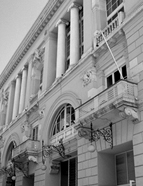

................................
Paradoxically, the Colonial Week programme coincided with the gradual diminishment of the SGL's role in technical-scientific cooperation on colonial matters with the state. The first signs of this decline emerged in 1924 with the establishment of the General Agency of the Colonies under the Ministry of the Colonies, which assumed responsibility for publishing a monthly Bulletin (launched in 1925 as a vehicle for colonial propaganda and technical-scientific information on the colonies and for the colonies). This agency also requested collections from the SGL’s archives for an exhibition in 1926. The SGL’s documentary collection, which had simultaneously fostered an overseas imaginary and technical-scientific knowledge, began to face progressive disinterest and isolation (particularly its museological component), with portions claimed by state agencies. This decline in the SGL's colonial expository discourse extended to the Colonial Exhibition organised directly by the state in 1934 at the Palácio de Cristal Gardens in Porto (modelled on major European temporary exhibitions of the late 19th century, such as the 1931 International Colonial Exhibition in Paris) and the Portuguese World Exhibition in Lisbon (1940). Additionally, the reorganisation of the Geographic Missions and Colonial Research Board initiated by the Ministry of the Colonies in 1945, with technical-scientific support from the Higher Institute of Social and Overseas Political Sciences beginning in 1963, further diminished the SGL’s prominence. Thus, nationalist authorities directly assumed control of colonial political programmes, bypassing intermediary civil entities such as the SGL.
The historical studies promoted and published under the aegis of the SGL were thematically aligned and focused on justifying and proving Portugal’s historical rights in Africa. This was achieved through the publication of a collection of documents in multiple languages within the context of a new phase of European colonial expansion. Until then, discovery and occupation were fundamental criteria for establishing a country’s territorial claims. However, following the Berlin Conference, a new framework of international law was introduced, based on the principles of effective occupation and freedom of navigation on major rivers. With its substantial historical claims but limited economic and military capacity on the ground, Portugal found its interests in Africa compromised under this new legal regime. In response to this competitive environment, the SGL focused its activities on reproducing late 18th- and early 19th-century nautical charts and records stored in the Ministry of the Navy's archives. These were translated into English and French and disseminated to foreign institutions, conferences, and international exhibitions. This historiographical habitus in defence of Portugal's historical rights was later revived in 1954 within the context of India’s occupation of Portuguese territories in Dadrá and Nagar Haveli. History also became a central domain for the SGL to project its colonial ideology and national unity. Operating within a positivist historiographical framework, dominated by event-centred history, the SGL also mobilised a series of biographical studies of national heroes. This approach indicated a selective relationship with Portugal’s history, further accentuated during the Estado Novo period. For example, figures such as João IV, Prince Henry the Navigator, Gil Vicente, Vasco da Gama, Pedro Álvares Cabral, the Marquis of Sá da Bandeira, Gago Coutinho, and Silva Porto were highlighted, while the actions of figures like the Marquis of Pombal received little emphasis. Within this gallery of national achievements and heroes, the SGL found a significant niche for publications, some of which stemmed from the curiosity of non-historian members (e.g., works by Gago Coutinho on Bartolomeu Dias, Vasco da Gama, or the discovery of Australia). This focus also extended to a vast number of commemorations, featuring parades, exhibitions, and conferences. Organisationally, history was one of the professional sections included in the 1895 statutes. Presidents of this section included notable figures such as Damião Peres, Hernâni Cidade, and Virgínia Rau. However, over time, the section's activities waned, eventually entering a prolonged period of inactivity after the tenure of the latter historian.
This work is financed by national funds through FCT - Foundation for Science and Technology, I.P, in the scope of the projects UIDB/04311/2020 and UIDP/04311/2020.
